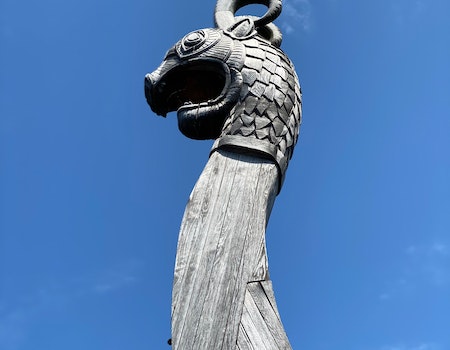Viking Goblets
Stories similar to this that you might like too.
In the Norse world of the late tenth and early eleventh centuries, one type of drinking vessel was ubiquitous: goblets called “víking,” or “gobs.” In Old Norse, the word means not only a cup made of gold but also “gold” in general.
It is possible that these were simply fancy cups used by the rich rather than being a common form of drinking vessels for all classes. The name may be derived from Old English wīc, which means “a gift given to someone on special occasion”; another possibility is that it derives from “wec,” meaning “to drink,” which is similar to the Danish words for both wine and beer (both in Norwegian, Danish and Swedish) as well as for water.
The earliest known mention of such an item dates to about 850 AD when there were many mentions of them by various writers.
These gobs could be plain or decorated with a variety of designs. Some were flat-bottomed whereas others had a flared rim like a bowl and they came in two different heights: tall ones (called torsk) measuring roughly five inches high, and shorter ones (called kjöttr), which were four inches.
They are made of hammered gold sheeting or plaques and were often set with pearls or other small gems. One famous example of a goblet with a pearl is found at the Stora Alvastra burial mound in Sweden; its maker was a woman named Hildisvíni who lived from 875 to 925 AD. Another inscription reads:
“She died on the thirteenth of March on the day before the spring equinox in the year one thousand two hundred and fifty-nine on this spot where her husband’s tomb stands.” That is the first instance I have seen where a date is mentioned; it shows that she would have been born in approximately 855, almost certainly around 856.
This is the same Hildisvíni who married Gunnar Olafsson, king of Iceland, in 862, although he later killed her father and brother and imprisoned his wife.
As the years passed, people started using gobs for drinking tea, not wine or ale, but it is unlikely they drank their coffee out of them. The most common beverage drunk out of these golden cups was mead, a fermented honey-based drink similar to beer that was popular throughout Europe during this time.
Many people believe that they were also used for eating bread and butter as well as meat pies.
They were also highly prized among collectors and could sell for thousands of dollars today. They were usually made of solid gold sheeting and set with jewels (some were even set with precious stones). These were made in large numbers and used for daily consumption.
Their value lies not so much in rarity but rather in their beauty and their association with royalty. As one collector put it, “The more elaborate they are, the better. A beautiful goblet will always be worth a fortune because if you want to own one that says ‘I am rich,’ then all you need to do is show up at a party.”
***
Danish Vases
There is some disagreement as to whether the vase style called “Daneland” or “danish,” which originated in Denmark (also known as Jutland), really belongs to this period. However, since it was made in the same places as the other forms of glassware and porcelain, I have included it here.
It seems likely that they were inspired by the pottery and earthenware known as størrelse, which began appearing in Scandinavia and Germany in the ninth century and became very popular in Denmark after the mid-ninth century.
The Danes seem to have perfected the technique for making thin layers of colored lead and tin oxide on clay and firing it. They were fired to a bright orange color and were used for everything from tableware to jewelry.
They are thought to have been introduced to Denmark by the Danes who sailed to the Mediterranean in search of trade goods, probably in the sixth and seventh centuries. There are examples of Danish vases dating back to the eighth century.
The main place where they were produced was in what is now southern Sweden, in and around the modern city of Kalmar, although the largest center of production in the north was at the mouth of the river Nilsö in Ladebucht on the island of Gotland, which was part of Sweden until the Treaty of Roskilde in 1361.
In the south, the area around the Danish city of Ribe, which is just west of where we visited Kronborg Castle, was a major center. Today only two of the seven surviving Danish glassmaking kilns are still in working order.
Vases were made mostly out of red, blue, and yellow clay. The glazes were applied in layers, starting with a thick coat of white and then adding different colors to get the desired effect. Most of the early examples are unglazed, but as time went on glazing techniques improved and they became brightly colored.
Some were decorated with patterns of raised dots. The vase that is considered the oldest in Europe is found at Ellinghus, which was excavated in 1883 by the archaeologist Johan Christian Dahl, who wrote an account of his discovery.
He described it as being about nine inches high, which means it must date to the second half of the ninth century. It is a squat form made from yellowish-green clay and has a shallow neck, suggesting it may have been used to hold a liquid such as water.
Ellington was built on the site of a settlement that had existed there since at least the eighth century. It seems that the vase was made there and then placed inside the earth of a grave. It was found within five feet of where one of its owners was laid to rest.
One theory is that they may have made it for him on his deathbed, so he could use it as he lay dying. The fact that it was found near its owner suggests that the man might have been an important person and a warrior. It was probably buried along with some of his belongings and weapons.
In the twentieth century, archaeologists uncovered a second example of a Danish vase from a gravesite on Gotland. This one was found at a cemetery on the island’s eastern coast, near the town of Skanör, on a hill above a lake. It is a small vase with a round top and an open base that is six inches high.
The design features concentric rings that are made up of concentric circles. It is similar to the design on a silver coin found nearby. The coins are often referred to as “Skanör dollars” and are thought to have been minted around 840–845. Since both coins and the vase share a common design, they suggest the presence of a wealthy community at the time. It was first believed that the vase was a funerary urn, but later evidence showed that this was wrong; they were instead thought to have been made by a skilled artisan who had traveled there from Denmark.
As with many things associated with the Viking Age, the truth behind this vase is unclear. Its provenance is unknown: how did it get to Gotland? Who made it and for whom? And why was it buried in a cemetery? But what is certain is that it was not made before the tenth century.
The third type of Danish vase has been dated to the late eighth century at Ellinghus and was discovered in the grave of a rich woman in Hørup on Funen. She was a member of what has been dubbed the Hørup Culture, named after the village where she was buried.
These were members of the so-called Western European Culture group. Like the Danes, these people spoke a Scandinavian language and belonged to a culture that stretched across western Sweden, the northern coasts of Denmark and Norway, the Faroe Islands, and parts of Iceland.
They are considered to be a separate group from the earlier Jelling Culture of the fifth and sixth centuries. Their society seems to have been more centralized than that of their predecessors, and there are records of them sending ambassadors to other places to try to negotiate trade agreements and settlements.
The vase that was found at Hørup dates to approximately 870 and depicts three women standing together and holding something in their hands. The image shows them as they are today – dressed in bright clothes, with colorful headdresses and carrying wicker baskets – rather than being dressed like warriors or berserkers.
They may all be mothers and they seem to represent different generations, as one looks to be much older than the others. It is likely that they were meant to show wealth and status. The fact that one of them holds an empty basket shows that it was intended for someone else, perhaps the deceased.
Archaeologists have identified another type of vase known as a hønsing-vessel (a hansi meaning “household vessel”) that was produced in the early eighth century by a different artist. It is smaller, about four inches high, and shaped like a wine jug or pewter cup.
A number of these vessels were found on Funen and some of them feature a scene showing two young boys playing with a ball. It is thought that this image was used to indicate that this was a vessel that would be used in a household environment and was not meant for ritual purposes.
There is also a curious story relating to this period that is still debated among scholars. Many of these vases seem to include images of gods, which were rare until this period. It is suggested that these scenes symbolized a shift toward a new religion.
It was thought that they may have been used when the dead were buried because they showed the power and authority of the god. It was common practice for gravesites to be decorated with images of gods in order to appease these spirits as they departed into the afterlife.
The existence of the images on these vases suggests that there was a movement away from this old custom towards a more religious belief system that focused on the concept of Odin.
It remains unclear as to whether these changes happened slowly or suddenly; the vases suggest a move away from paganism, but if you believe in Norse mythology, Odin himself died and rose again.
***
The idea of the Viking Age began to take shape during the nineteenth century. The term itself comes from a book by the British archaeologist Sir James George Frazer titled The Golden Bough: A Study in Magic and Religion, published in 1890. He was trying to explain the development of cultural ideas that he saw as having developed over millennia.
The End


